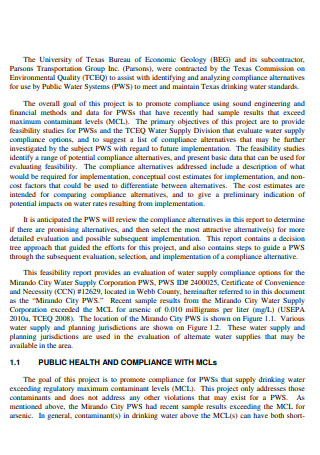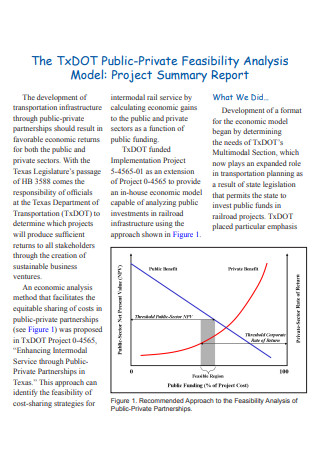12+ SAMPLE Feasibility Analysis Report
-

Pre Feasibility Analysis Report
download now -

Economic Feasibility Analysis Report
download now -

Feasibility Alternative Evaluation Analysis Report
download now -

Feasibility Assessment Analysis Report
download now -

Financial Feasibility Analysis Report
download now -

Engineering Feasibility Analysis Report
download now -

Feasibility Study Analysis Final Report
download now -

Water Supply Feasibility Analysis Report
download now -

Market Feasibility Analysis Report
download now -

Public-Private Feasibility Analysis Report
download now -

Sample Financial Feasibility Analysis Report
download now -

Feasibility Analysis Project Report
download now -

Feasibility Analysis Report Example
download now
FREE Feasibility Analysis Report s to Download
12+ SAMPLE Feasibility Analysis Report
What Is a Feasibility Analysis Report?
Components of a Feasibility Analysis Report
How To Conduct a Feasibility Study
FAQs
How do you write a feasibility analysis report?
What is a feasibility analysis?
What are the different types of feasibility?
As such, respective teams must collect all necessary information and evidence to prove success. Through data collection and data analysis, accompanied with the necessary revisions for certain complications, teams can proceed to enforce plans, projects, and programs. Constructing a feasibility analysis report comes in handy to help the organization. What is a feasibility analysis report, and what advantages does it provide businesses and industries that use the document? The article contains valuable information about the report, including its definition, composition, and a guide to help individuals create the document. A section also answers frequently asked questions regarding the report, coming from various sectors of business and society.
What Is a Feasibility Analysis Report?
A feasibility analysis report is a business document that contains findings of a feasibility study or analysis. The document aims to determine the viability of an idea. For example, it checks whether a program is feasible in technical and legal terms and economically justifiable. It details whether or not a given project will be worth the business investment or if the project has the possibility of being achievable and doable. Different reasons and factors influence the feasibility of programs and projects, including the requirement of too many resources that prevents the resources from performing essential functions that can become costly for the organization. As a result, the business wastes time and money when implementing a program without the projected earn-back rate making the project unprofitable. A well-designed feasibility analysis or study must deliver a historical background relating to the business or project. The details that the feasibility analysis must include are product or service description, accounting or financial statements, operations and management information, marketing research, policy, and procedure, financial data, legal requirements, and tax obligations. Feasibility studies precede technical development and project implementations.
According to a research article entitled, “Are some feasibility studies more feasible than others? A review of the outcomes of feasibility studies on the ISCRTN registry” published in November 2021, the high feasibility rate of 83 percent suggests that non-feasible studies are subject to publication biases or there are too many similar feasibility studies that clutter the research pathway due to their redundancy.
Components of a Feasibility Analysis Report
The main role of the feasibility analysis report is to provide the company with essential information to encourage and convince clients, investors, company executives, and employees to give their full support to a project. Various companies utilize feasibility analysis reports, and there is no one format to write the report. Different organizations have ways of constructing the report to persuade the readers and audience to agree to a certain project. Regardless, feasibility analysis reports must contain the following components for its target audience to acquire sufficient and compelling information about the proposed project.
How To Conduct a Feasibility Study
Since there is no one format for writing the feasibility report, you must remember to indicate all necessary information and items to persuade and convince the reader to give their full support to the implementation of the project. If there are individuals that are new or have no background in developing a feasibility analysis report, the next section provides valuable tips on how to conduct a comprehensive feasibility study for the report.
-
1. Develop a Preliminary Analysis
The purpose of conducting a preliminary analysis is to filter project ideas before the company puts in the time, effort, and resources to implement them. There are two sets of activities that the individual conducts. First, they must describe or outline the specifics of planned services, target markets, and demographics of services. It must also determine whether there are any insurmountable barriers to hinder the implementation of the project. If the capital requirements for starting or continuing the project are unavailable or unaffordable or if several factors hinder effective marketing techniques to referral sources, then it means that the project has little room for success. If the information that the individual provides sufficient evidence that indicates the project’s success, then the next step is to proceed with conducting the feasibility analysis.
-
2. Design a Projected Income Statement for the Project
When organizing the anticipated income of the project, it must consider direct and indirect costs while taking into account the income growth curve. Derive the generated income by working backward from the anticipated income to get the revenue figures for the person to build a projected income statement. Different factors influence the figures of the income statement, including fees and volume of the provided services and the necessary revenue adjustments like reimbursements levels.
-
3. Execute the Market Survey
Generating a market survey is crucial to the feasibility report. It is necessary to have a comprehensive and accurate market survey to have a realistic revenue projection. When preparing the market survey, it must define the market’s geographical influence, review market trends, demographical profiles, cultural factors, and purchasing power of consumers. It must also contain competitor analysis according to similar products and services they offer to determine the strengths and weaknesses, including prices, product lines, referral sources, site locations, advertising activities, service quality, consumer satisfaction, and sales figures. The market survey must also determine the market area volume and expected market share, plus an estimate of possible market expansions.
-
4. Plan for the Business Operations and Structural Organization
There must be a clear organization and operational structure for the business that determines the technical feasibility and costs for the start-up procedures, fixed investments, and operations. There must also be extensive plans that detail the use of equipment, merchandising methods, location and building design, personnel availability and costs, supply availability, and overhead costs.
-
5. Setup a Start-Up Balance Sheet
The balance sheet must reflect the possible assets and liabilities of the business with accuracy at the time operations begin and before it generates the predetermined income. Incorporate an asset list for the practice operations and include information about items, cost, sources, and financing procedures. Incurred liabilities and investments that the practice requires must be clear. It is also necessary to consider whether to lease or buy equipment, buildings, and land and how to finance assets purchases and accounts receivable.
-
6. Review and Analyze All Collected Data
It is crucial to review all the information that the researcher collects. The responsible individuals must determine the need for further analysis to implement changes and revisions. The steps to take during the review and analysis include reexamining the projected income statement and comparing it with the asset list and balance sheet to check if there are realistic expectations. There must also be risk analysis and contingency plans in place when applying changes in the current market that results in altered projections.
FAQs
How do you write a feasibility analysis report?
When talking about writing a feasibility analysis or study report, the individual must:
- Describe the proposed project
- Outline the possible solutions and recommendations stemming from the project
- Identify evaluation criteria for the solutions
- Classify which of the solutions are the most feasible
- Derive a conclusion statement
What is a feasibility analysis?
A feasibility analysis or a feasibility study is a process that seeks to determine the strengths, weaknesses, viability, and profitability of a project proposal, an existing system, or the entirety of a company. The procedure also helps many business professionals to plan step-by-step methods towards the completion of a project, identify possible challenges, and specify the solutions resulting from it.
What are the different types of feasibility?
Feasibility studies gauge the overall success rate of projects for investors, clients, and other stakeholders to support the cause. There are various types of feasibility studies present in the business world. These include technical feasibility, economic feasibility, legal feasibility, operational feasibility, and scheduling feasibility.
Writing a feasibility analysis report becomes crucial to many industries and sectors, especially in manufacturing and other businesses that focus on production. The principal purpose of the report is to guarantee that the organization does not waste its time, money, and resources on projects that are not viable from the beginning. If the company decides to push through on a project, the feasibility analysis report contains essential information that helps convince clients, investors, stakeholders, company executives, and employees to give their support to the project. Develop a feasibility analysis report for your organization by downloading from the 12+ SAMPLE Feasibility Analysis Report in PDF from Sample.net.
